tutorial design and build wind turbine propeller blades
Understand and master the wind turbine propeller blade design and construction:
After seeing the basic parameters in wind turbine and wind power, we will see now how to build a propeller with HELICIEL. We will sizing, test, and edit designs of our wind turbine propeller blades.
- Organization and design phases:
- Selection of the fluid. (density vs. altitude)
- Wind speed reference..
- Diameter of wind turbine. (Choice of power)
- Determining the rotational speed.
- Select an optimum profile

- 1:selection of the fluid: In the tab project / "select ambient fluid" open editor fluid and select air at 20 degrees then "use this fluid", and click "Yes" to enter the altitude defining the density::
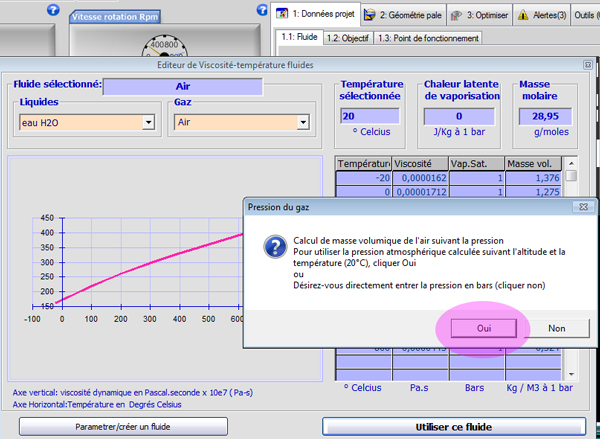
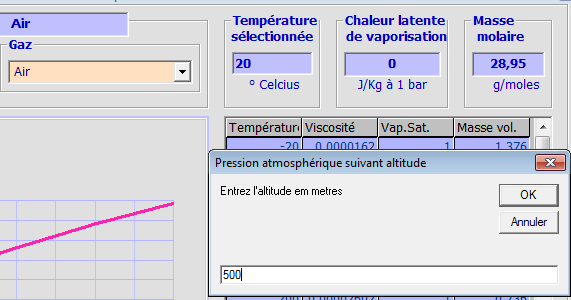
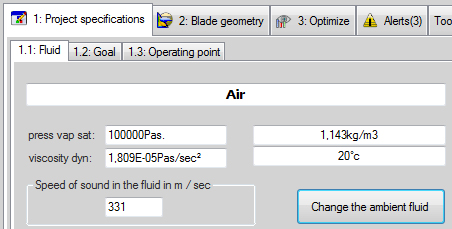
- 2:Wind speed reference:
- Let's use an USA wind map from HELICIEL available under the "Goal" tab software:
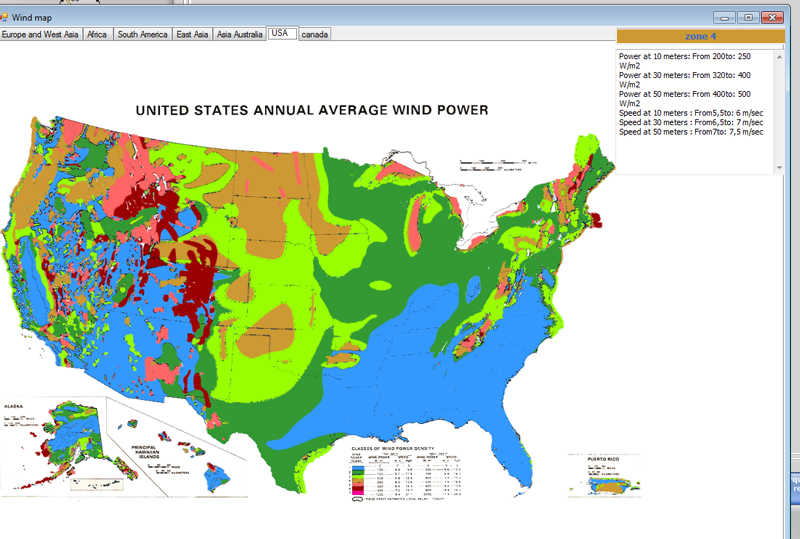
We choose the wind speed at 10 meters =5.5 m/sec
- Reference speed selected=5.5 m/sec
- The instantaneous power of the site per m² = 0.5 X density X (speed)³ = 0.5 X 1,143 X 1 X (5,5)³= 95 w par m²
- We note here that the instantaneous power is different from the averaged power given on the map...(see:Wind speed wind turbine power)
- with wind speed and density we can calculate the instantaneous power per m² = 0.5 x density x S x (speed)³ = 0.5 X 1,143 X 1 X (5,5)³= 95 w per m²,
- Betz said that we can actually get 60% of the instant energy=> 95X0.6 = 57 w/m²
- We know that the loss due to the various components of the system efficiency, leaves only 80% of the power: 57 X 0.8 = 45.6 w/m².
- Our formula for our wind turbine power is: 3.14 X radius² x 45.6. With this formula, we establish the different powers, depending on the wind rotor diameters:
let's decide that our wind turbine blades lenght is 2 meters (diameter=4 meters). The captured surface will therefore be:3.14 X 2²=12.56m², and the power will be: 12.56 x 45.6 = 572.7 Watts
We could make the selection of the rotational speed of the propeller based on the speed of the generator producing approximately the estimated power to the shaft. But nothing would say that our propeller rotates the optimum speed for the selected wind speed, and our performance would certainly be poor. With heliciel, let's looking for the optimum rotational speed of the propeller:
- 4:Determining the speed of rotation:
4 a) search for optimum speed:
- in the tab "project specifications">Operating point enter the fluid velocity:5.5m/sec
- and a rotational speed, at random, of 1000 revolutions / minutes
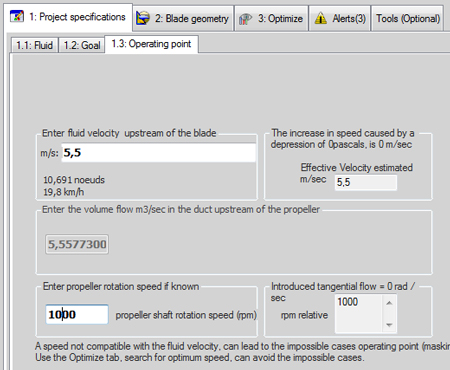
- in de tab 2:Blade Geometry>Blade dimensions, Enter the radius at the blade tip(2000) and a radius at the blade root with the cursor to 10%.

- enter a chord of 200 mm at root and 50mm at tip and do not forget to click on "linearize" to update the distribution of the blade chords:

- make sure your profile law is set to a constant profile, if the profile is not naca1408, by clicking "select default profile", select the NACA 1408 profile in the database.

- Now let's rebuild our propeller (click on
) to see if the parameters are valid. Note that the blade tip speed, generated by the rotation speed and our blade length (754 km / h), approach the speed of sound.. .!
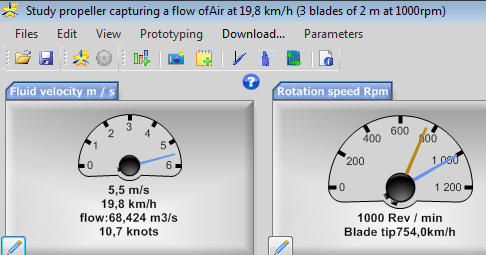
The list of alerts, reports errors and solutions: Among errors you find "Failure to zero or negative induction of item No ...". This is indicative of an improper rotation speed. In the solutions offered are "optimize speed rotation." This returns you to the tab 3: Optimize: click "automatique search speed rotation". A search procedure Optimum speed for the wind speed and blade geometry selected is launched. An Optimum speed (350 revolutions per minute) is proposed to you, click yes, héliciel rebuilt propeller and refreshes the performance of your propeller:
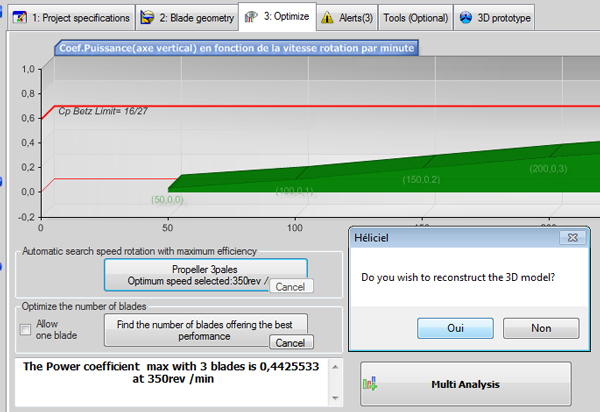
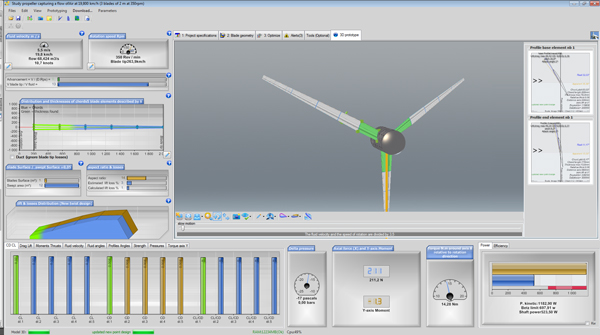
Our wind turbine and blade's twist is rebuilt , Results are given in the Output pane at the bottom of the screen. The shaft power is 523 Watts and our rotor's efficiency is 0.443. Heliciel twisted blades, profiles see the fluid with an optimal incidence angle, generating an otptimal lift drag ratio ( according to induced velocities) .Our propeller in its current geometry and the current operating point is at its optimal twisting, all other settings in twists give inferior performance..Let us now try to adjust the distribution of chords to gain some performance
Modify the chords of our blade and see how the optimal speed and performance are evolving: 400 at the blade' root and 100 at the tip, do not forget to "linearize" to update the intermediate string of répartion:

In the tab 3"optimize " re-launching a search for optimal rotation speed. During the search of the optimal speed, observe the evolution of the relative blade tip speed / wind speed, and efficiency approaching the Betz limit... you will see that the efficiency reaches a maximum when this parameter is 7 ... (for a 3 blades rotor)

- Increasing blades's chords had the effect of reducing the optimum rotation speed, it is now 188 rpm. The efficiency increased to 0.46 and our power has increased slightly now we have 546 w. We can see that when increasing the area occupied by the blades by increasing their chords (or their number) , the optimum rotation speed is reduced. We retain this phenomenon to adjust its Optimum speed. For example, a slow generator or a pump.
Keep a blade geometry 400 mm at the root and 200 mm at the tip. In the "optimize" tab, you can make a combined research of optimal speed and number blades, this feature is a bit long and can take up to 15 minutes of research..., to avoid this delay, directly adjust the number of blade to 13 and search for optimal speed. you should get this:
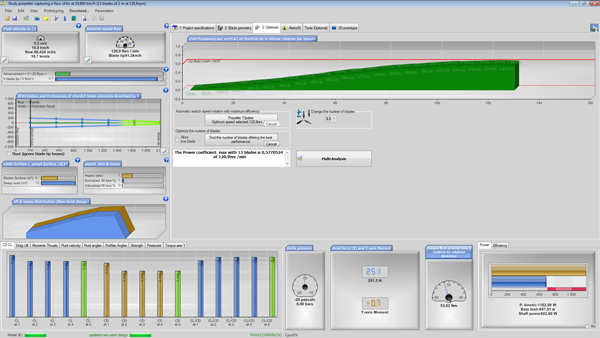
We get optimum speed 122 rpmThis speed decrease is Conform to phenomenon described above, but the surprise is the efficiency reaching the Betz limit therefore the theoretical optimum. It is theoretically impossible to make a wind turbine with better performance. The only drawback is that 13 blades, it's a bit expensive to manufacture...but how to explain this increase of efficiency?
Grab a cup of coffee, take a break, but what follows is (from my humble opinion) the key concept of the mastery of design éoilennes, so a particular concentration is required here:
- When the speed is low, the apparent wind and the angles of incidence of profiles section generate a better alignment of lift and drag forces , with the plane of rotation
- But when it slows down, the apparent gap between the blades increases, if we do not want to lose the energy of the air passing between the blades, we must add blades,but not too much because they might disturb each other.There is therefore an ideal rotation speed for each number of blades..
- For an optimal "Efficiency / manufacturing cost" ratio , a minimum number of blade is desired.
- But to use all the air with a low number of blades, we must rotate faster so that "apparent space" between the blades is reduced to its ideal size.
- When the speed is fast, the apparent wind and the angles of incidence of profiles section generate a bad alignment of lift and drag forces , with the plane of rotation...
Disadvantages of these high speeds are balanced by the fact that the profiles produce better performance at high speeds, for the same power, high speed generates less torque reaction, therefore less rotation of the flow, so less losses ......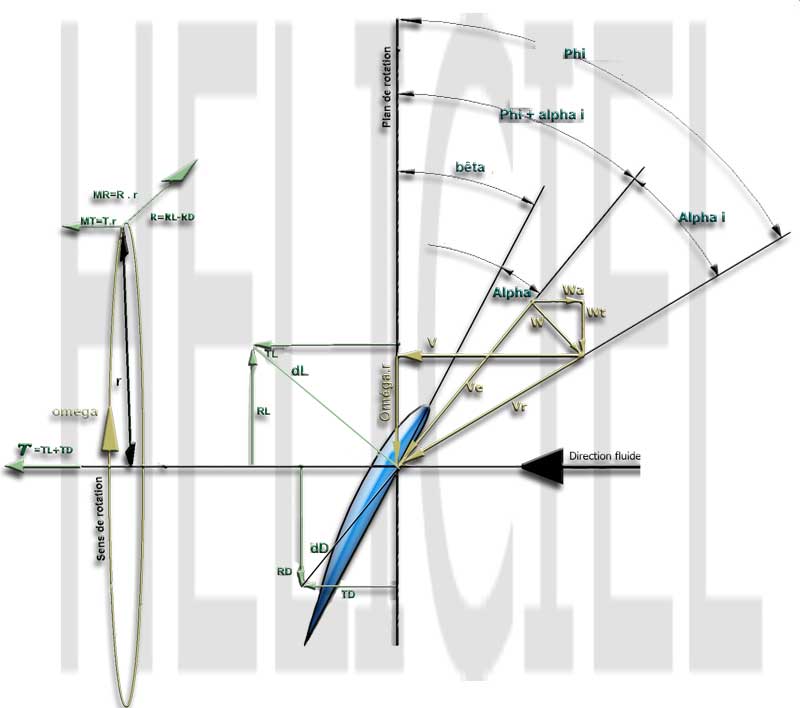
- High specific speeds
benefits disadvantages Captures the energy with a low blade number, thus providing the benefits of the low number of blades: economic cost in manufacturing the apparent wind and the angles of incidence of profiles section generate a bad alignment of lift and drag forces , with the plane of rotation, This requires good profiles quality sometimes difficult to achieve. Rotating tangential flow downstream of the propeller Revelle energy lost by the system. At equal power (Pw = torque nm x speed rad rotation / sec), a high rotational speed uses less torque generated so less losses. sometimes requires assistance of starting when the starting torque is insufficient speed of rotation closer to generator system (the price of the generator and gear box will be lower) speed of rotation and torque not suitable for pumping limited exposure to violent winds
- low specific speed
This list is far from complete because each turbine is the result of a compromise argued by the constraints of the project . In this tutorial we opted for a small number of blades to generate electricity. We take three blades. The specific speed (blade tip speed / wind speed) for optimal 3-blade wind turbines is generally 7.
benefits disadvantages Allows the use of simple forms blades economic cost in manufacturing to get a good performance it takes a lot of blades (more expensive, heavier, to the wind when storms ...) start even at low wind speeds Rotating tangential flow downstream of the propeller Revelle energy lost by the system. At equal power (Pw = torque nm x speed rad rotation / sec), a low rotational speed uses more torque generated so more losses. speed of rotation and torque suited for pumping speed of rotation far to generator system (the price of the generator and gear box will be higher)
5: Select an optimum profile: Due to the blades tip losses and low tangential velocities at the blades root, the propeller area working the most and best is around 0.75 blade radius, so we will lend special attention to this area and choose profile whose lift/drag ratio is the best at speeds (nb Reynolds) found in this area.
- Keep a blade geometry 400 mm ( root) and 200 mm (tip) with a rotation speed of 188 RPM (apply the speed in tab 1.3 "operating point") and apply 3 blades (tab 3"optimize")and rebuild (clic
 )
) - looking for another way to make performance:
- To know the relative speed, or more precisely the Reynolds number of the "precious" area,select the item number 4 in the 3D tab. This displays a diagram of the profiles defining and framing the blade element:
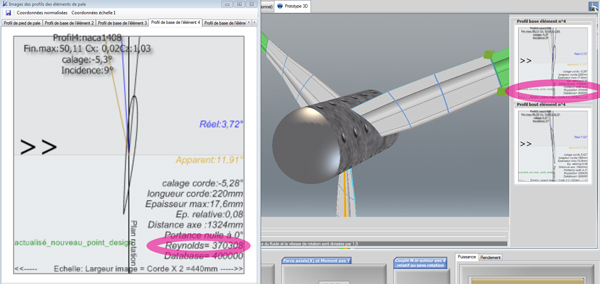
The Reynolds number for this item is around 370,000 and the naca 1408 profile gives us a maximum lift/drag ratio of 50. Looking for in our database of profiles, more efficient profile to this Reynolds number:
- in tab 2.2 blade geometry /profiles low clic "select default profile":

- Sort the database by lift/drag ratio (click the head of f_max column)
- select a good lift/drag ratio for reynolds 300 000 (5 zeros only, not to be confused with 3 000 000) by clicking on the line "nom_profil=naca 64a410 f_max =89.17 Re=300 000:
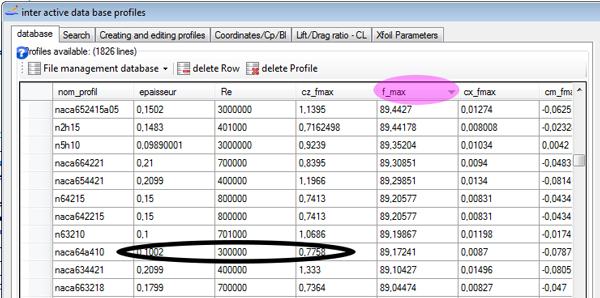
- and apply the default profile for our wind turbine by clicking "Profile Default":
Heliciel apply the selected profile, your wind turbine and rebuilt the optimal twist.
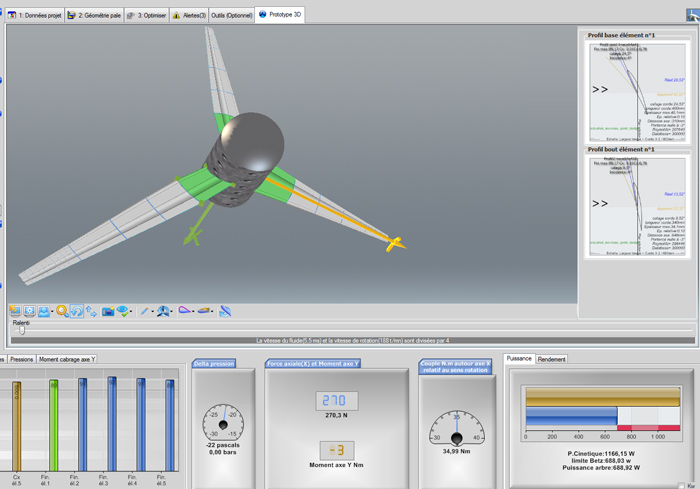
We obtain optimal performance slightly above the Betz limit, which is theoretically impossible ! (no panic it exceeds 0.9 watts for 688 watts, this is just a calculation imprecision ). We could increase the number of elements (tab " optionals tools") to increase the accuracy (made the test with 10 items and you'll be 675 watts)
Here we are at the end, I hope this tutorial, with a boost from Heliciel software, participate in making you an expert in the design of wind rotor. I remain at your disposal for any comments or additional information via __contact@heliciel.com_
- JF Iglesias (developer Heliciel).

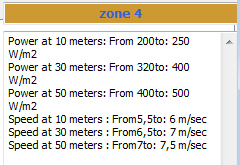
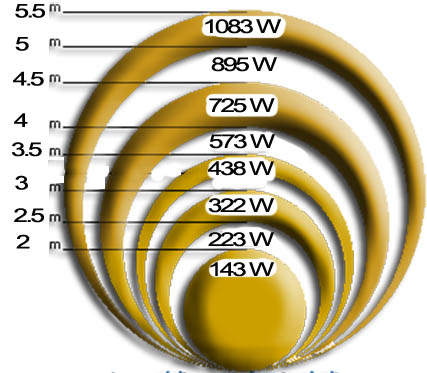
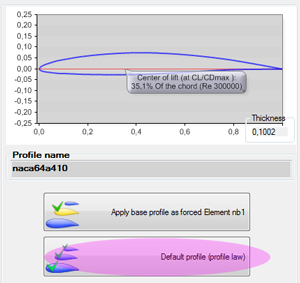
 Global site map
Global site map Mecaflux
Mecaflux Tutorials Mecaflux Pro3D
Tutorials Mecaflux Pro3D Tutorials Heliciel
Tutorials Heliciel Mecaflux Store
Mecaflux Store Compare software functions
Compare software functions Quotes, Orders, Payment Methods
Quotes, Orders, Payment Methods project technical studies
project technical studies